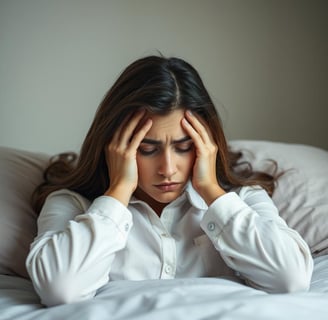Managing Anxiety: Practical Techniques That Work
🧘WELLNESS TIPS


Anxiety can feel overwhelming and isolating, affecting nearly every aspect of our lives. Whether it's persistent worry about the future or situational anxiety triggered by specific events, most people experience anxiety at some point—many of us daily. The good news is that there are numerous practical techniques that can help you manage anxiety effectively. This article offers friendly guidance to help you navigate your path toward calmer seas.
Understanding Anxiety: What’s Happening in the Body?
Before diving into helpful techniques, it’s useful to understand what anxiety is. It’s a natural response to stress, characterized by feelings of tension, worried thoughts, and physical changes like increased blood pressure and rapid heartbeat. While occasional anxiety is normal, chronic anxiety can be debilitating and may require professional intervention.
Recognizing the signs of anxiety is the first step toward managing it. Symptoms can include excessive worrying, restlessness, fatigue, difficulty concentrating, and irritability, along with physical symptoms such as sweating or a racing heart.
1. Practice Mindfulness and Meditation
One of the most effective tools for managing anxiety is mindfulness, which encourages living in the present moment without judgment. Mindfulness practices like meditation, deep breathing, and body scanning can reduce anxiety symptoms significantly.
How to Get Started:
Mindfulness Meditation: Dedicate 10-15 minutes a day to sit quietly and focus on your breath. Notice how your chest rises and falls, and gently bring your attention back to your breath if your mind wanders.
Guided Imagery: Use guided imagery by listening to recordings that help paint peaceful scenarios in your mind. This can create a calming mental escape.
Body Scan: Lie down comfortably and mentally scan your body from head to toe, releasing tension in each area. This promotes relaxation and helps you connect with your body.
2. Journaling: Unloading Your Thoughts
Writing can be a powerful release. Journaling allows you to express your worries and thoughts on paper, providing clarity and sometimes even revealing patterns in your thinking.
Tips for Effective Journaling:
Start Small: Begin with just a few sentences each day about what’s on your mind. Don’t worry about grammar or structure; just let it flow.
Gratitude Journaling: Keep a separate section for things you are grateful for each day. This can shift your focus from worry to positive experiences.
Problem-Solving Journal: When faced with particular anxiety-inducing situations, list potential solutions, pros and cons, and what you can control.
3. Physical Activity: The Natural Anxiety Reliever
Physical exercise is one of the best natural ways to reduce anxiety. Exercise releases endorphins, chemicals in the brain that act as natural painkillers and mood elevators. Plus, it can provide a constructive outlet for pent-up energy.
Incorporating Exercise Into Your Routine:
Find What You Love: Whether it’s dancing, jogging, yoga, or team sports, choose activities that make you happy. This will increase the likelihood of sticking with them.
Start Small: If you’re new to exercise, try short walks daily or a few stretches. Gradually increase intensity and duration to avoid burnout.
4. Deep Breathing Techniques
Deep breathing exercises can immediately soothe anxious thoughts and physical symptoms. They send a message to your brain to relax, signaling a reduction in stress.
Simple Deep Breathing Technique:
Find a comfortable seated position and close your eyes.
Inhale slowly through your nose for a count of four.
Hold your breath for a count of four.
Exhale gently through your mouth for a count of four.
Repeat this cycle for a few minutes, focusing on your breath.
5. Establish a Routine
For many people, the unpredictability of daily life can exacerbate anxiety. Creating a structured routine can help provide a sense of control and predictability.
How to Develop a Daily Routine:
Morning Rituals: Start your day with grounding activities like stretching or a warm cup of tea.
Set Work Hours: Establish specific times for work, breaks, and personal activities. Stick to your schedule as closely as possible.
Wind Down for Sleep: Create a calming nighttime routine to sign off your day—think reading, gentle yoga, or herbal tea.
6. Reach Out: Connection Matters
Don’t underestimate the power of your social circle. Sharing your feelings with friends or family can provide emotional support and lessen feelings of isolation. Sometimes, just talking about what you’re going through can lift a heavy weight off your shoulders.
Tips for Connecting:
Call a Friend: Reach out to a trusted friend or family member when you feel anxious. They might offer insights, encourage you, or simply listen.
Join Support Groups: Consider local or online support groups. Engaging with people who share similar experiences can foster understanding and community.
Explore Therapies: If your anxiety persists, therapy options like Cognitive Behavioral Therapy (CBT) can equip you with tools to manage your anxiety more effectively.
Conclusion: Finding What Works for You
Managing anxiety requires dedication, compassion for yourself, and sometimes several trials to find what methods resonate best with you. It's important to remember that anxiety is manageable, and seeking help is a sign of strength. As you explore these practical techniques, be patient with yourself. Cultivating mindfulness, establishing routines, staying active, and reaching out to others can make a substantial difference in your life.
Anxiety may always be a part of the human experience, but with the right tools and techniques, you can take charge of your well-being and live your life to the fullest. Embrace this journey—every small step you take is a victory on your path to managing anxiety.
